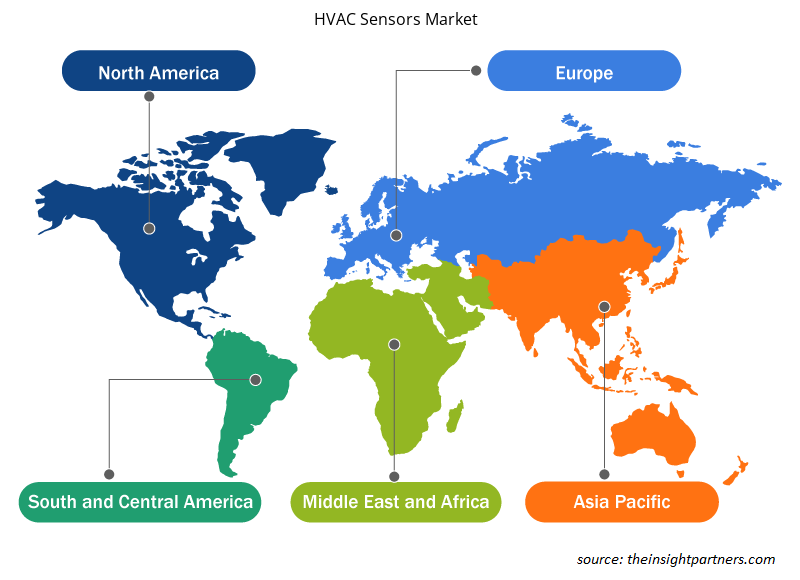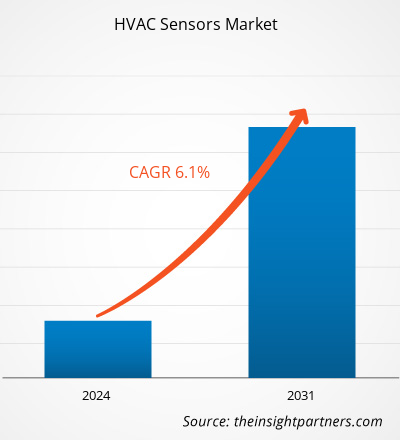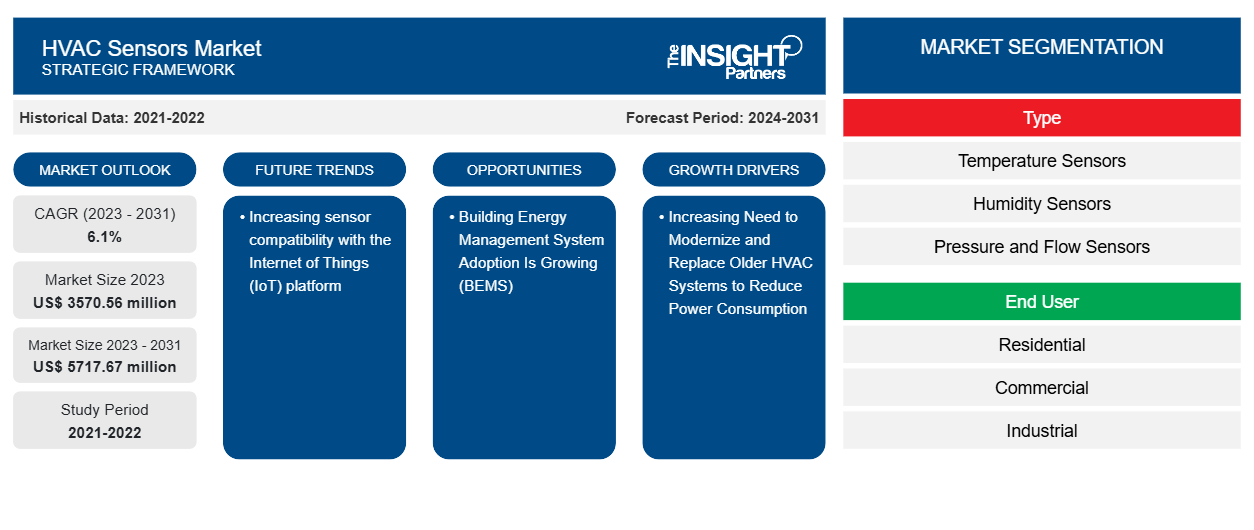Der Markt für HVAC-Sensoren soll von 3.570,56 Millionen US-Dollar im Jahr 2023 auf 5.717,67 Millionen US-Dollar im Jahr 2031 anwachsen. Für den Zeitraum 2023–2031 wird eine durchschnittliche jährliche Wachstumsrate (CAGR) von 6,1 % erwartet.
Die zunehmende Sensorkompatibilität mit der Plattform des Internets der Dinge (IoT) wird voraussichtlich ein wichtiger Markttrend für HLK-Sensoren bleiben.
Marktanalyse für HVAC-Sensoren
Der Markt für HLK-Sensoren wurde von mehreren Branchen genutzt, darunter Gewerbe, Wohnen, Automobil und andere. Heutzutage herrscht in der Geschäftswelt ein harter Wettbewerb, da führende Organisationen Umweltschutz, Produktivität, Qualität, Sicherheit und Schutz priorisieren müssen. In den letzten Jahren wurden HLK-Systeme in vielen Programmen auf der ganzen Welt umfassend eingesetzt. Zahlreiche Sensoren, darunter Druck- und Temperatursensoren, finden eine Verwendung, die sie ermöglicht. HLK-Systeme sorgen für gute Luftqualität und thermischen Komfort sowohl im Auto- als auch im Zimmerinnenraum. Die HLK-Sensoren werden verwendet, um die Bedürfnisse verschiedener Endbenutzer zu erfüllen, denen Energieeffizienz wichtig ist. Sie helfen dabei, ordnungsgemäß gepflegte Innenräume mit geringem Stromverbrauch bereitzustellen.
Marktübersicht für HVAC-Sensoren
HLK-Systeme werden häufig eingesetzt, um den Energieverbrauch zu halten, zu kontrollieren und dadurch zu senken. In die Frequenz ist ein Audiogerät integriert, das einen realen Zustand wie die Temperatur oder die Zielwelt nachahmt. Der wichtigste HLK-Sensortyp hilft dabei, die richtige Temperatur zu halten und die benötigte Temperatur anzupassen, indem er die Eingangstemperatur von der Gebäude- oder Raumtemperatur unterscheidet. Für Endbenutzer, darunter Industrie-, Wohn- und Gewerbegebäude , können HLK-Sensoren verschiedene Vorgänge wie Luftdruck, Temperatur und Qualität verwalten, steuern und überwachen. Infolgedessen werden HLK-Sensoren aufgrund der Notwendigkeit, Energie zu sparen, immer häufiger eingesetzt.
Passen Sie diesen Bericht Ihren Anforderungen an
Sie erhalten kostenlose Anpassungen an jedem Bericht, einschließlich Teilen dieses Berichts oder einer Analyse auf Länderebene, eines Excel-Datenpakets sowie tolle Angebote und Rabatte für Start-ups und Universitäten.
-
Holen Sie sich die wichtigsten Markttrends aus diesem Bericht.Dieses KOSTENLOSE Beispiel umfasst eine Datenanalyse von Markttrends bis hin zu Schätzungen und Prognosen.
Markttreiber und Chancen für HVAC-Sensoren
Zunehmender Bedarf an Modernisierung und Austausch älterer HLK-Systeme zur Reduzierung des Stromverbrauchs
Das Weltwirtschaftsforum schätzt, dass Gebäude für über 40 % der energiebedingten Kohlendioxidemissionen und fast ein Drittel des weltweiten Energieverbrauchs verantwortlich sind. Etwa ein Drittel dieser Emissionen wird laut dem World Green Building Council durch die Energie verursacht, die für den Betrieb eines Gebäudes benötigt wird, wozu das Heizen, Kühlen und die Stromversorgung des Gebäudes gehören. Laut Iota Communications werden für ein durchschnittliches Bürogebäude jährlich etwa 30.000 US-Dollar für Strom ausgegeben. In einem gewerblichen Gebäude verbrauchen HLK-Systeme häufig am meisten Energie. Nach Schätzungen des US-Energieministeriums machen HLK-Systeme normalerweise 35 % des Energieverbrauchs eines Gebäudes aus. Der Bedarf an HLK-Systemen mit Luftfiltereigenschaften ist während der Pandemie gestiegen. Moderne Belüftungssysteme dienen einem entscheidenden Zweck der öffentlichen Gesundheit, indem sie die Luft filtern und Luftschadstoffe wie virushaltige Partikel reduzieren.
Die Nutzung von Gebäudeenergiemanagementsystemen nimmt zu (BEMS)
Gebäude können trotz ihrer exorbitanten Kosten nicht ohne HLK-Systeme funktionieren. Das australische Ministerium für Klimawandel, Energie, Umwelt und Wasser schätzt, dass ein durchschnittliches HLK-System etwa 40 % des gesamten Energieverbrauchs eines Gebäudes und 70 % seines Grundenergieverbrauchs verbraucht . Die computergestützten automatisierten Systeme, die als Gebäudeenergiemanagementsysteme (BEMS) bekannt sind, überwachen und regeln jedes energiebezogene System in Gebäuden, einschließlich mechanischer und elektrischer Geräte. Durch die präzise und automatisierte Steuerung von Energiesystemen und -versorgung schützt das Energiemanagement Unternehmen vor unnötigen Energieausgaben. Ein Unternehmen kann seinen derzeitigen Energieverbrauch mithilfe von BEMS um bis zu 10 % bis 30 % senken, behauptet Radiocrafts. Aufgrund des Konflikts zwischen Russland und der Ukraine steigen die Energiepreise in der EU in die Höhe. Daher wird erwartet, dass die Einführung eines Gebäudeenergiemanagementsystems (BEMS) den HLK-Akteuren im Prognosezeitraum neue Möglichkeiten bietet.
HVAC-Berichtssegmentierungsanalyse
Wichtige Segmente, die zur Ableitung der HVAC-Analyse beigetragen haben, sind Typ und Endbenutzer.
- Basierend auf dem Typ ist die HLK in Temperatursensoren, Feuchtigkeitssensoren, Druck- und Strömungssensoren, Bewegungssensoren, Rauch- und Gassensoren und andere unterteilt. Das Segment der Temperatursensoren hatte 2023 einen größeren Marktanteil.
Basierend auf dem Endbenutzer ist der Markt für HLK-Sensoren in die Bereiche Wohnen, Gewerbe und Industrie segmentiert.
Marktanteilsanalyse für HLK-Sensoren nach geografischer Lage
Der geografische Umfang des Marktberichts für HLK-Sensoren ist hauptsächlich in fünf Regionen unterteilt: Nordamerika, Asien-Pazifik, Europa, Naher Osten und Afrika sowie Südamerika/Süd- und Mittelamerika. Aufgrund einer großen Anzahl moderner, gut entwickelter Infrastruktur, darunter Geschäftsgebäude, Industrieanlagen und Wohnimmobilien, hat Nordamerika den größten Marktanteil für HLK-Sensoren und -Steuerungen. Aufgrund der Fülle an Gebäuden mit komplexen HLK-Systemen gibt es einen beträchtlichen Markt für HLK-Sensoren und -Steuerungen.
Regionale Einblicke in den Markt für HVAC-Sensoren
Die regionalen Trends und Faktoren, die den Markt für HVAC-Sensoren im Prognosezeitraum beeinflussen, wurden von den Analysten von Insight Partners ausführlich erläutert. In diesem Abschnitt werden auch die Marktsegmente und die Geografie für HVAC-Sensoren in Nordamerika, Europa, im asiatisch-pazifischen Raum, im Nahen Osten und Afrika sowie in Süd- und Mittelamerika erörtert.

- Holen Sie sich die regionalspezifischen Daten für den Markt für HVAC-Sensoren
Umfang des Marktberichts zu HVAC-Sensoren
| Berichtsattribut | Details |
|---|---|
| Marktgröße im Jahr 2023 | 3570,56 Millionen US-Dollar |
| Marktgröße bis 2031 | 5717,67 Millionen US-Dollar |
| Globale CAGR (2023 - 2031) | 6,1 % |
| Historische Daten | 2021-2022 |
| Prognosezeitraum | 2024–2031 |
| Abgedeckte Segmente |
Nach Typ
|
| Abgedeckte Regionen und Länder |
Nordamerika
|
| Marktführer und wichtige Unternehmensprofile |
|
Marktteilnehmerdichte für HVAC-Sensoren: Auswirkungen auf die Geschäftsdynamik verstehen
Der Markt für HVAC-Sensoren wächst rasant, angetrieben durch die steigende Nachfrage der Endnutzer aufgrund von Faktoren wie sich entwickelnden Verbraucherpräferenzen, technologischen Fortschritten und einem größeren Bewusstsein für die Vorteile des Produkts. Mit steigender Nachfrage erweitern Unternehmen ihr Angebot, entwickeln Innovationen, um die Bedürfnisse der Verbraucher zu erfüllen, und nutzen neue Trends, was das Marktwachstum weiter ankurbelt.
Die Marktteilnehmerdichte bezieht sich auf die Verteilung von Firmen oder Unternehmen, die in einem bestimmten Markt oder einer bestimmten Branche tätig sind. Sie gibt an, wie viele Wettbewerber (Marktteilnehmer) in einem bestimmten Marktraum im Verhältnis zu seiner Größe oder seinem gesamten Marktwert präsent sind.
Die wichtigsten auf dem Markt für HLK-Sensoren tätigen Unternehmen sind:
- Siemens AG
- Emerson Electric Co.
- Honeywell International Inc.
- Johnson Controls, Inc.
- Schneider Electric
- TE Connectivity Ltd.
Haftungsausschluss : Die oben aufgeführten Unternehmen sind nicht in einer bestimmten Reihenfolge aufgeführt.

- Überblick über die wichtigsten Akteure auf dem Markt für HVAC-Sensoren
Marktnachrichten und aktuelle Entwicklungen zu HVAC-Sensoren
Der Markt für HLK-Sensoren wird durch die Erfassung qualitativer und quantitativer Daten nach Primär- und Sekundärforschung bewertet, die wichtige Unternehmensveröffentlichungen, Verbandsdaten und Datenbanken umfasst. Im Folgenden finden Sie eine Liste der Entwicklungen auf dem Markt für Sprach- und Sprechstörungen sowie Strategien:
- Im Oktober 2023 kündigte Sensata Technologies die Markteinführung des Sensata Resonix RGD-Sensors an, des ersten Leckerkennungssensors mit UL-Zertifizierung für mehrere A2L-Kältemittelgase, die in Heizungs-, Lüftungs- und Klimaanlagen (HVAC) verwendet werden. Die neuen Leckerkennungssensoren unterstützen HVAC-Hersteller bei der Umstellung auf Kältemittel mit geringerer Auswirkung auf die globale Erwärmung. (Quelle: Sensata Technologies, Pressemitteilung)
- Im Januar 2023 brachte Third Reality einen Temperatur- und Feuchtigkeitssensor auf den Markt. (Quelle: Third Reality, Pressemitteilung)
Marktbericht zu HVAC-Sensoren – Umfang und Ergebnisse
Der Bericht „Marktgröße und Prognose für HVAC-Sensoren (2021–2031)“ bietet eine detaillierte Analyse des Marktes, die die folgenden Bereiche abdeckt:
- Marktgröße und Prognose auf globaler, regionaler und Länderebene für alle wichtigen Marktsegmente, die im Rahmen des Projekts abgedeckt sind
- Marktdynamik wie Treiber, Beschränkungen und wichtige Chancen
- Wichtige Zukunftstrends
- Detaillierte PEST/Porters Five Forces- und SWOT-Analyse
- Globale und regionale Marktanalyse mit wichtigen Markttrends, wichtigen Akteuren, Vorschriften und aktuellen Marktentwicklungen
- Branchenlandschaft und Wettbewerbsanalyse, einschließlich Marktkonzentration, Heatmap-Analyse, prominenten Akteuren und aktuellen Entwicklungen
- Detaillierte Firmenprofile
- Historische Analyse (2 Jahre), Basisjahr, Prognose (7 Jahre) mit CAGR
- PEST- und SWOT-Analyse
- Marktgröße Wert/Volumen – Global, Regional, Land
- Branchen- und Wettbewerbslandschaft
- Excel-Datensatz
Aktuelle Berichte
Verwandte Berichte
Erfahrungsberichte
Grund zum Kauf
- Fundierte Entscheidungsfindung
- Marktdynamik verstehen
- Wettbewerbsanalyse
- Kundeneinblicke
- Marktprognosen
- Risikominimierung
- Strategische Planung
- Investitionsbegründung
- Identifizierung neuer Märkte
- Verbesserung von Marketingstrategien
- Steigerung der Betriebseffizienz
- Anpassung an regulatorische Trends























 Kostenlose Probe anfordern für - Markt für HLK-Sensoren
Kostenlose Probe anfordern für - Markt für HLK-Sensoren